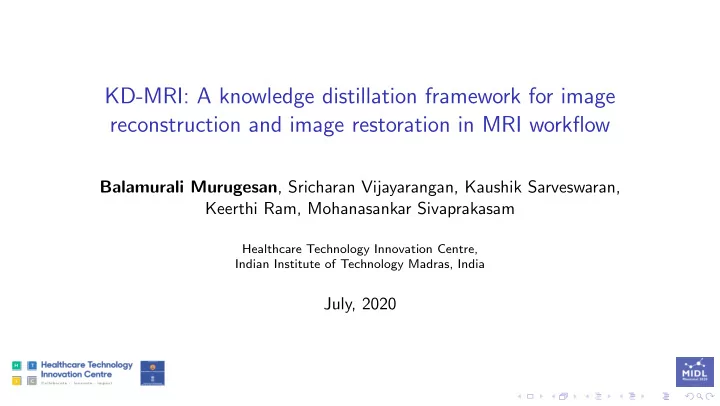

KD-MRI: A knowledge distillation framework for image reconstruction and image restoration in MRI workflow Balamurali Murugesan , Sricharan Vijayarangan, Kaushik Sarveswaran, Keerthi Ram, Mohanasankar Sivaprakasam Healthcare Technology Innovation Centre, Indian Institute of Technology Madras, India July, 2020
Table of Contents Introduction Motivation Solution Methodology KD for MRI reconstruction Block Diagram Training procedure Results Quantitative comparison Qualitative comparison Conclusion
Motivation Magnetic Resonance Imaging (MRI) workflow consists of image acquisition, reconstruction, restoration, registration and analysis. Deep learning networks have shown encouraging results for every stage in the MRI workflow. Deep learning networks are specific to task, dataset (anatomical study, contrast). For MRI reconstruction, deep learning networks are also specific to type of degradation (acceleration factor, undersampling mask). Integration of deep learning models to MRI workflow demands larger storage and compute power. Development of memory-efficient model is required.
Solution Model compression - Deploying state-of-the-art deep networks in low-power and resource limited devices without significant drop in accuracy. Knowledge distillation (KD) - Develop compact models with ease of deployment. KD - student model (memory efficient, lower performance network) learns from teacher model (memory intensive, higher performance network) to improve the student’s accuracy. For MRI reconstruction and restoration, we propose: • Attention-based feature distillation - Student learn the intermediate representation of the teacher. • Imitation loss - Regularizer to the reconstruction loss.
MRI reconstruction MRI reconstruction • Transformation of Fourier space (k-space) data to image domain. • MRI is a slow acquisition modality, acceleration is done by under sampling k-space. • De-alias the artifact due to undersampling and provide reconstruction equivalent of fully sampled k-space. Deep Cascade - Convolution Neural Network (DC-CNN) • Cascade of convolutional neural networks (CNN) and a data consistency (DC) layer. • CNN - To learn Image-to-Image mapping, DC - To provide consistency in Fourier domain. • n c cascades, every cascade has n d convolution layers and 1 DC layer. Teacher DC-CNN • n c = 5 , n d = 5 Student DC-CNN • n c = 5, n d = 3
KD for MRI reconstruction Attention based feature distillation • Attention transfer loss for information distillation: Q j Q j � S T L AT = || − || 2 (1) || Q j || Q j S || 2 T || 2 j ∈ I where Q j S = vec ( F sum ( A j S )), Q j T = vec ( F sum ( A j i =1 | A i | 2 and I denote the set of T )), F sum ( A ) = � C teacher-student convolution layers which is selected for attention transfer Imitation Loss • Regularizer to the student reconstruction loss L S total = α L S rec + (1 − α ) L imit (2) where L S rec = || x − x S rec || is the loss between student prediction and target, L imit = || x T rec − x S rec || is the imitation loss between teacher and student prediction
Block Diagram
Training procedure cnn weights θ T using teacher reconstruction Step1: Train the teacher DC-CNN f T loss L T rec = || x − x T rec || cnn weights θ S using attention transfer loss Step2: Train the student DC-CNN f S L AT = || Q T − Q S || between teacher and student Step3: Load the weights θ S from Step2 and re-train f S cnn weights θ S using student reconstruction and imitation loss L S total = α || x − x S rec || + (1 − α ) || x T rec − x S rec ||
Quantitative comparison 4x 5x 8x PSNR SSIM PSNR SSIM PSNR SSIM ZF 24.27 ± 3.10 0.6996 ± 0.08 23.82 ± 3.11 0.6742 ± 0.08 22.83 ± 3.11 0.6344 ± 0.09 Teacher 32.51 ± 3.23 0.9157 ± 0.04 31.49 ± 3.32 0.9002 ± 0.04 28.43 ± 3.13 0.8335 ± 0.06 Cardiac Student 31.92 ± 3.17 0.9053 ± 0.04 30.79 ± 3.24 0.8863 ± 0.05 27.87 ± 3.11 0.8156 ± 0.07 Ours 32.07 ± 3.21 0.9084 ± 0.04 31.01 ± 3.27 0.8913 ± 0.04 28.11 ± 3.17 0.8236 ± 0.07 ZF 31.38 ± 1.02 0.6651 ± 0.02 29.93 ± 0.80 0.6304 ± 0.02 29.37 ± 0.98 0.6065 ± 0.03 Teacher 40.03 ± 2.00 0.9781 ± 0.00 39.03 ± 1.28 0.971 ± 0.00 35.04 ± 1.38 0.9374 ± 0.01 Brain Student 39.36 ± 1.82 0.9753 ± 0.00 38.58 ± 1.28 0.9674 ± 0.00 34.39 ± 1.26 0.9281 ± 0.01 Ours 39.8 ± 1.89 0.977 ± 0.00 38.78 ± 1.24 0.9688 ± 0.00 34.83 ± 1.35 0.9337 ± 0.01 ZF 29.66 ± 3.86 0.8066 ± 0.08 29.2 ± 3.87 0.8007 ± 0.08 28.71 ± 3.88 0.7985 ± 0.08 Teacher 37.15 ± 3.55 0.9436 ± 0.03 35.16 ± 3.46 0.9231 ± 0.03 32.53 ± 3.49 0.8887 ± 0.05 Knee Student 36.37 ± 3.53 0.9367 ± 0.03 34.37 ± 3.47 0.9144 ± 0.04 31.92 ± 3.58 0.8804 ± 0.05 Ours 36.7 ± 3.52 0.9392 ± 0.03 34.71 ± 3.44 0.9181 ± 0.04 32.32 ± 3.57 0.8867 ± 0.05
Qualitative comparison Figure: From Left to Right: Zero-filled, Target, Teacher, Student, Ours (KD-MRI), Teacher Residue, Student Residue, KD-MRI Residue
Conclusion We proposed a knowledge distillation (KD) framework for image to image problems in the MRI workflow in order to develop compact, low-parameter models without a significant drop in performance. We propose obtaining teacher supervision through a combination of attention transfer and imitation loss. We demonstrated its efficacy on the DC-CNN network and show consistent improvements in student reconstruction across datasets and acceleration factors.
Thank you Paper - https://arxiv.org/abs/2004.05319 Code - https://github.com/Bala93/KD-MRI Contact - balamurali@htic.iitm.ac.in
Recommend
More recommend